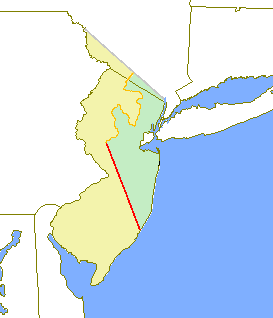The Province of East Jersey, along with the Province of West Jersey, between 1674 and 1702 in accordance with the Quintipartite Deed were two distinct political divisions of the Province of New Jersey, which became the U.S. state of New Jersey. The two provinces were amalgamated in 1702. East Jersey's capital was located at Perth Amboy. Determination of an exact location for a border between West Jersey and East Jersey was often a matter of dispute.
The area comprising East Jersey had been part of New Netherland. Early settlement (including today's Bergen and Hudson counties) by the Dutch included Pavonia (1633), Vriessendael (1640) and Achter Col (1642) These settlements were compromised in Kieft's War (1643â€"1645) and the Peach Tree War (1655â€"1660). Settlers again returned to the western shores of the Hudson River in the 1660 formation of Bergen, New Netherland, which would become the first permanent European settlement in the territory of the modern state of New Jersey. During the Second Anglo-Dutch War, on August 27, 1664, New Amsterdam surrendered to English forces.
Between 1664 and 1674 most settlement was from other parts of the Americas, especially New England, Long Island, and the West Indies. Elizabethtown and Newark in particular had a strong Puritan character. South of the Raritan River the Monmouth Tract was developed primarily by Quakers from Long Island. In 1675, East Jersey was partitioned into four counties for administrative purposes: Bergen County, Essex County, Middlesex County, and Monmouth County. There were seven established towns: Shrewsbury, Middleton, Piscataway, Woodbridge, Elizabethtown, Newark, and Bergen. In a survey taken in 1684 the population was estimated to be 3500 individuals in about 700 families. (African slaves were not included).
Although a number of the East Jersey proprietors in England were Quakers and the governor through most of the 1680s was the leading Quaker Robert Barclay, the Quaker influence on government was not significant. Even the immigration instigated by Barclay was oriented toward promoting Scottish influence more than Quaker influence. In 1682 Barclay and the other Scottish proprietors began the development of Perth Amboy as the capital of the province.
Frequent disputes between the residents and the mostly-absentee proprietors over land ownership and quitrents plagued the province until its surrender to Queen Anne's government in 1702.
Constitution

- See: History of the New Jersey State Constitution#East Jersey Constitution
Governors of East Jersey (1674â€"1702)

- See also: Lords Proprietor (1665â€"1703) and Governors under the Proprietors (1665â€"1674)
See also
- Concession and Agreement
- List of colonial governors of New Jersey
References
Other sources
- Winfield, Charles H. History of the County of Hudson, New Jersey (New York: Kennard & Hay Printing Company, 1874)
- Harvey, Cornelius B., ed. Genealogical History of Hudson and Bergen Counties, New Jersey (New York: The New Jersey Genealogical Publishing Co., 1900)
- John Fiske. The Dutch and Quaker Colonies of America. Vol. I (New York: Houghton, Mifflin and Company, 1903)
- Lovero, Joan D. Hudson County: The Left Bank (Sun Valley. CA: American Historical Press, 1999)
External links
- Where was the West Jersey/East Jersey line?
- Bergen Township, Past and Present
- Jersey City's Colonial Background
- Overview of Hudson County Heritage
- Bergen County Historic Society
- Colonial Charters, Grants and Related Documents (at "New Jersey"). The Avalon Project: Documents in Law, History and Diplomacy. Lillian Goldman Law Library (Yale Law School). Retrieved 2010-03-14. This website has links to the following documents:
- 1664 â€" The Duke of York's Release to John Ford Berkeley, and Sir George Carteret, 24 June
- 1664 â€" The Concession and Agreement of the Lords Proprietors of the Province of New Caesarea, or New Jersey, to and With All and Every the Adventurers and All Such as Shall Settle or Plant There
- 1672 â€" A Declaration of the True Intent and Meaning of us the Lords Proprietors, and Explanation of There Concessions Made to the Adventurers and Planters of New Caesarea or New Jersey
- 1674 â€" His Royal Highness's Grant to the Lords Proprietors, Sir George Carteret, 29 July
- 1676 â€" The Charter or Fundamental Laws, of West New Jersey, Agreed Upon
- 1676 â€" Quintipartite Deed of Revision, Between E. and W Jersey: July 1
- 1680 â€" Duke of York's Second Grant to William Penn, Gawn Lawry, Nicholas Lucas, John Eldridge, Edmund Warner, and Edward Byllynge, for the Soil and Government of West New Jersey-August 6
- 1681 â€" Province of West New-Jersey, in America, The 25th of the Ninth Month Called November
- 1682 â€" Duke of York's Confirmation to the 24 Proprietors: 14 March
- 1683 â€" The Fundamental Constitutions for the Province of East New Jersey in America
- 1683 â€" The King's Letter Recognizing the Proprietors' Right to the Soil and Government
- 1702 â€" Surrender from the Proprietors of East and West New Jersey, of Their Pretended Right of Government to Her Majesty
- 1709 â€" The Queen's Acceptance of the Surrender of Government; April 17
- 1712 â€" Charles II's Grant of New England to the Duke of York, 1676 â€" Exemplified by Queen Anne
- 1776 â€" Constitution of New Jersey
- The journall of the procedure of the governor and Councill of the province of East New Jersey : from and after the first day of December Anno Dmni 1682






0 komentar :
Posting Komentar